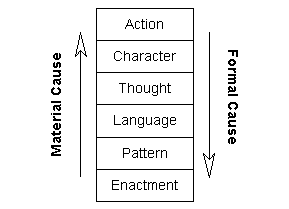
Storytelling is an ancient human activity, present from oral traditions thousands of years old, through medieval theatre and the invention of the printing press, to the latest e-book. With the advent of computers, however, there has been a desire to change, not only the medium through which we share narratives, but their very nature. We want to make narratives interactive. We want to blur the line between game and narrative, creating stories that change based on their readers' choices.
However, before we can accomplish this effectively, we need to first understand the nature of narrative. Then we can explore how to graft interactive controls to a story and still produce a satisfying result.
To begin our study of narrative, we will review of a number of established works. However, each of these works has a particular focus stemming from its author's historical context.
Aristotle, the famous Greek philosopher, lived in the 4th century B.C.E. A student of Plato and a tutor of Alexander the Great, Aristotle wrote on everything from logic to biology to ethics. His works have been lost, found, interpreted, and translated. Sections have been interpolated, and most were only lecture notes to begin with. Over the years, a large body of neo-Aristotlean thought has been established. This body consists of reinterpretations, extensions, and commentary that, though based on Aristotle's philosophical frameworks and still associated with his name, were not part of his original works.
In Poetics, Aristotle aims to understand the nature of the poetic arts--epic and tragic poetry, comedy, dithyramb, and music. However, at least in the sections of his work that have survived, he focuses his analysis primarily on tragedy.
Only in past 200 hundred years has serious consideration been given to the source and context of Greek tragedy. Greek tragedies were performed during annual festivals dedicated to Dionysus. Each day, a different poet would demonstrate three tragic plays, followed by a burlesque play. These plays developed gradually from religious hymns to Dionysus. Over two centuries, the standard number of actors increased from one to three. These plays maintained their lyric nature, focusing on inner feeling and motive more than simple action. They were serious works, conveying both historic and legendary stories, as well as philosophical and religious ideals.
In his introduction to Aristotle, Fergusson explores the effects of these dithyramb roots more closely. The tragic effect--the purgation of emotion--likely comes from its religious history. Also, many of the mythic elements present in dithyrambs have carried over into tragedy. Citing the work of Gilbert Murray, Fergusson shows that both tragedy and dithyramb tend to convey a contest between opposites (Agon), leading to a ritual sacrifice or death (Pathos), usually announced by a Messenger. This leads to a lamentation (Threnos) filled with contrary emotions--the death of the old is also the triumph of the new. The discovery or recognition of the slain hero (Anagnorisis), followed by his resurrection or apotheosis, brings a change from grief to joy (Preipeteia). This pattern of struggle, suffering, sacrifice, and rebirth heavily influences most classic Greek tragedy.
Despite focusing primarily on such a rigid, classical form of tragedy, Aristotle has still provided the basis for many later theories. His view (perhaps slightly expanded) remains one of the most widely accepted views of drama.
Gustav Freytag was born in 1816. During his lifetime, he was a scholar, poet, novelist, critic, playwright, editor, and publicist. He wrote Technique of the Drama in 1863, and it went through six German editions before being translated into English in 1895.
Freytag builds most of his discussion on the foundations laid by Aristotle. Though he does not deal solely with tragedy, he does restrict himself to "serious drama", with classic Greek plays, Shakespeare, and some German plays as examples. Freytag held that a good theory of drama could provide both a guide for creation and a context for criticism. Rather than rigid laws that constrain creativity, rules of drama should be like craftsmen's traditions that let the playwright benefit from the wisdom of the great artisans that preceded him.
Educated in theatre, Brenda Laurel worked as a software engineer and programmer writing educational programs and interactive fairy tales for children. She also worked for Atari. Returning to academia, she proposed using theories of drama and narrative (particularly Aristotle and Freytag) as a framework for designing human-computer interfaces. Though her model may not have won wide support in the field of HCI, her work combining narrative and interaction could be very valuable in the study of interactive narrative. Computers as Theatre was published in 1991.
Mark Stephens Meadows has a background in image composition and animation, as well as graphic, interface, character, environment and information design. Rather than looking at drama, he explores narrative elements in images, comics, animation, software, and interactive computer games. Pause and Effect: The Art of Interactive Narrative was published in 2003.
Keith Johnstone has worked as a teacher and playwright. He worked, wrote, taught, and performed with a number of theatre studios and performance troupes, including the Royal Court Theatre. He has been exploring creativity and improvisation since the late 1950s. His book, Impro: Improvisation and the Theatre, published in 1981, explores a number of games and techniques for reawakening spontaneous creativity. Some of these techniques include group storytelling a word a time, automatic writing, and wearing masks. His work is well-regarded in the field of improv.
Aristotle holds that art is "imitation". Art forms differ in their objects, medium, and mode of imitation. "Tragedy is an imitation, not of men, but of an action and of life, and life consists in action" (Poetics VI). Thus, the primary "object" of tragedy is action. This action is not only physical events, but "praxis", which includes the motivation or rational purpose behind these events. To witness this motivation, we must also have characters who convey their thoughts to us. Thus, the three objects of tragedy are action, character, and thought.
The medium of tragedy is song and diction--that is, melody and spoken works. Its manner is spectacle. That is, tragedy is enacted before an audience. Though epic poetry shares the same medium, its manner is different--it is performed as simple narration.
Freytag essentially reiterates Aristotle's definition:
In an action, through characters, by means of words, tones, gestures, the drama presents those soul-processes which man experiences from the flashing up of an idea, to passionate desire and to a deed, as well as those inward emotions which are excited by his own deeds and those of others (Freytag, p104).
Also important to Freytag is the "idea" of the play. The playwright's "idea" is what directs the molding and selecting of material into the single unified action of the play. (Both Aristotle and Freytag describe reworking existing historical or legendary material, rather than creating entirely new stories.)
As Aristotle does, Freytag stresses that, for serious drama, we must understand the hero's motivation and inner passions, and not simply witness his actions. (Freytag goes on to provide many more guidelines for the construction of serious drama, such as the appropriate source of material, the affect of an audience on the experience of a drama, the place of the fanciful and magical, and the respectability of the subject matter and characters.)
Laurel also builds on Aristotle (in a very neo-Aristotlean way, based on the works of Sam Smiley) by supposing formal and material causes between the elements of tragedy. Aristotle lists the elements in order of principle importance: action, character, thought, diction (prose or verse), song (melody), spectacle (performance). Laurel reformulates these slightly as follows:

A formal cause is the form of something--what it is trying to be. The form of a house is the architect's design of it. (Or, more generally, the abstract form of "house-ness", of which a particular house takes part.) A material cause is the substance that comprises a thing. In our house example, the material cause would be the brick, mortar, and wood used in its construction.
So, in Laurel's model, the progression of formal causes is something like an abstract process of construction. We determine that the action necessitates particular characters, which then espouse certain thoughts, which are given in particular utterances of language. Patterns are slightly less clear, but seem to be any meaning-carrying signs. Aristotle claims music and harmony is an instinctual pleasure for humans; Laurel claims we find the same joy in recognizing patterns. Enactment would be all the sensory elements presented to the audience during the performance of the play.
When we make sense of a play as an audience, we extract patterns from the experience of the enactment. We discern meaningful language, from which we determine the character's thoughts and motives, which gives us an insight into the nature of those characters. The events these characters are involved in serves as the action of the play.
I mildly disagree with this model, however. First of all, Aristotle only listed the first three (action, character, and thought) of these elements as the objects of imitation; the others belong to the medium and the manner. If a story were pantomimed, Diction/Language and Song/Pattern would become Gesture, though the manner would still be Spectacle/Enactment. If the same story were written as text, the medium would be Diction/Language, but the manner would be different--Narration or Reading, perhaps. It seems that Language, Pattern, and Spectacle are not as essential to narrative as its objects.
Also, I think adding the causes constrains the elements to only affecting those element immediately above or below them in the stack. For example, in Laurel's model, characters are dictated solely by the action, which does not seem to leave room for background characters that provide setting or extended the development of other characters. In her model, language is seemingly the only way we can know a character's thoughts or motivation, when in practice we can tell much by their dress, gesture, and mannerisms. Either these other signs are a type of Language, or else we are determining character based on Pattern. Also, there are many "patterns"--such as background scenery, lighting, staging, literary references, etc--that enrich our experience of a play and add (metaphorical) meaning directly to the action as a whole.
Adding Freytag's notion of a play's seminal "idea", we could reformulate Laurel's model. We could assume that the playwright is attempting to convey a full "idea" (or experience or theme or perspective) to the audience. The principle means to do this is still through the action. However, all the other elements can directly reflect the central idea to some degree. For instance, the lighting may grow increasingly stark during a play to emphasize the polarization between characters and their increasing alienation from each other. Yet these patterns need not be part of the language or thought of any character. We may enjoy a particularly well-wrought line of dialogue, yet admit that it is more beautiful than it needs to be to simply advertise a character's internal state.
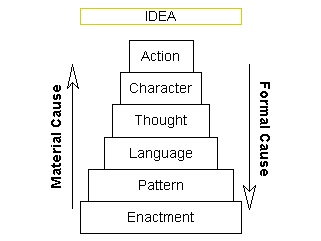
A modified version of Laurel model.
Johnstone too implies that action is key to narrative. However, he doesn't explore any of Aristotle's other elements. Instead, he holds that if you pay attention to the structure of the narrative, the content will take care of itself.
Not all authors hold that the primacy of narrative is action, however. Meadows claims that the essential component of narrative is perspective--choosing what to tell, as well as how to tell it and in what order. A football game may have all the elements of a drama--action, characters (players), thought (strategy), etc.--yet still seem a weak narrative, or none all. Meadows points out that this is because we lack a perspective. We are spectators to a series of events, not the audience of a story:
A football game quickly becomes a story when a sports-caster is there to narrate, providing opinion on who is doing what and why at what times. This is the role of the sports-caster; to insert opinion where there was only action (Meadows, p224).
Up to this point, I have be using drama and narrative synonymously. I feel justified in doing this because I consider narrative to refer to any kind of story, regardless of medium. All of the following are (usually) narratives in this sense: a tragic drama, an epic poem, a fantasy novel, a co-worker's tale of his weekend fishing trip, a comic book, a role-playing computer game. (Since we are using narrative in its broadest sense, the terms audience, reader, player, and user are largely synonymous here. All are recipients of a narrative, albeit through different mediums.)
This is not the only meaning of narrative in circulation, however. Laurel uses narrative to refer to a spoken or written account, as compared to drama, which relies on enactment or performance. Though the key difference is whether the story is narrated or enacted, Laurel claims that there are other common differences. Dramas tend to portray events in real-time (or in less time, if some of the events are omitted). Narratives can extend time by taking pages to describe a couple seconds of action. Drama tends to have a tighter unity of action, largely because it is constrained to a performance duration of only two to three hours. Narratives (such as books) can include action that is episodic, thematic, or tangential to the central action (Laurel 94-95).
Certainly, this is a good reminder that the medium makes a difference. However, in this review, we are looking for elements of narrative (once again in the broadest sense of narrative) that are common across mediums--whether movies, plays, or novels.
By common agreement, the essence of narrative is a cohesive action, a series of events, a plot. This action will likely need characters to bring it about, and it may not be a narrative until shaped through a certain perspective. But still, it is the action that is most essential. So what are the features of this action?
Aristotle defines a plot in general as "the arrangement of the incidents" (Poetics VI). With respect to tragedy in particular, a plot is
an imitation of an action that is complete, and whole and of a certain magnitude; for there may be a whole that is wanting in magnitude. A whole is that which has a beginning, a middle and an end (Poetics VII).
He goes on to explain that the plot should not start or end haphazardly. The internal parts should have an orderly arrangement. The whole should not be so large that spectators cannot easily grasp the unity and order it contains. Yet it must still be large enough to admit a change in fortune.
A tragedy should be but a single, unified action. (This is not true of epics, which are much longer and can include a number of connected but separate stories. Also, Aristotle admits the existence of tragedies with a "double thread of plot" (Poetics XIII), but holds these in lower esteem. An example from today would be soap operas, which are very long, contain multiple related plots, and are also held in low esteem as examples of the perfect narrative.) The parts of a plot should be connected through necessary and probable causes, "such that, if any one of them is displaced or removed, the whole will be disjointed and disturbed" (Poetics VII). Causes are probable when they are logical to us based on the characters' motives.
As already stated, a tragedy should include a change in fortune. The section of the tragedy from its beginning to this change in fortune is called the Complication, and the part after it is the Unraveling (or Denouement). Other parts of a tragedy that do not generalize as well to other forms of drama include Recognition and Reversal of Situation. These are present in "complex" plots, but not in "simple" plots. A tragedy should have consistent, true-to-life characters with good purpose and propriety. And a tragedy should bring about a feeling of fear and pity in its audience.
Freytag divided drama into its play and counter-play. The play is the part of the drama when the hero affects the world--when his will and desire prompt him to an action that changes the world around him. The counter-play is the part of the drama when the hero is plagued by his opponents or his environment--when the world about him generates feelings within him and drives his actions. Either the play or the counter-play can come first. The transition from one to the other is the climax of the drama. (This is clearly influenced by Aristotle's complication, change of fortune, and denouement.)
Within this basic structure, a plot can be further broken down into 5 parts and 3 crises.
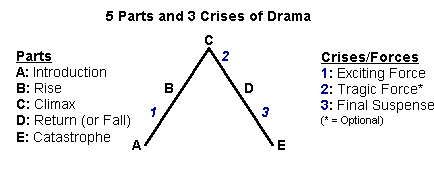
This "triangle" is what Freytag is best known for. He gives no axes for this diagram. He describes "rising" and "falling" movements, but does not describe precisely what is being increased or decreased. Presumably, since the two sides comprise the play and the counter-play, we see the world-affecting action of the hero and the hero-affecting action of the world in return. Moving along this plot triangle, we encounter the following plot elements:
Freytag covers some additional plot details, such as how these element correspond to scenes of a drama, but most of these details are particular to his focus on the dramas of his time.
Freytag's notion of graphing the plot has inspired later critics, who have added to his model and disagreed over many of his labels. Laurel offers a modern version of Freytag's triangle. Though no longer a triangle, it still bears his name.
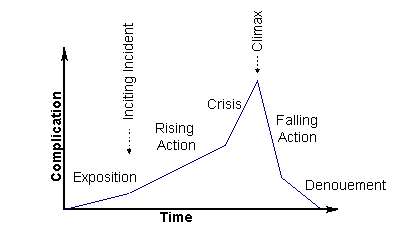
A modern version of "Freytag's Triangle."
In fact, many Freytag Triangles now include risings and fallings within each segment, making for jagged rising actions and jagged falling actions. This is because when we are engaged in a narrative, we do not experience a smooth rise to the climax. The plot takes many twists and turns, some questions are answered on the way, and various small problems are encountered and resolved before the climax.
One part of Freytag's model no longer present in this modern reformulation is the play and counter-play. While these may not be the most useful concepts in themselves, the notion that there is a tension or conflict between opposing forces in a narrative may be a key attribute. However, none of the other authors reviewed mention conflict as a integral part of narrative.
And an important question still remains in this updated model. What exactly is this "complication" that increases during the course of the plot? Surely this is the secret to how plot structure relates to the audience's experience, since we feel something increasing and decreasing during the performance of a drama. We will explore the nature of this audience response in the next section.
Laurel presents another model of plot which she calls the "flying wedge". In this model, a drama opens with (practically) unlimited potential. As the first scene progresses, certain possibilities are eliminated based on the setting, character's motives, etc. As the plot progresses, the audience begins to suspect certain outcomes to be more probable than others. Eventually, we reach the climax--the moment when all other possible story paths are eliminated--and we are left with a single, necessary outcome.
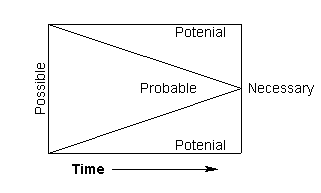
Laurel's Flying Wedge
Thinking of plot in terms of decreasing the possible/probable alternatives may be a helpful model for computer-generated plots. It may be possible to start with a tree or graph of possible plot lines and gradually eliminate improbable paths until we reach a climax. In any case, it is a reminder that Freytag's Triangle is not the only model of plot structure.
It is important to distinguish between a finished narrative and the process of creating it. Freytag and Aristotle imply that an author starts with the "idea" of a drama, and then conceives its full and complete action, and then determines the characters. While some may create narratives this way, it may be the exception rather than the rule. Many authors start with only a single image or a good character, and the plot develops as they write. They may not know the ending when they start, or their originally intended ending may change.
Another example of this sort of plot creation is Johnstone's improvisational theatre. In improv, there is no single, unified action or idea at the outset of the performance. Instead, the focus in on generating only the next successive event or line of dialog. Yet a basic plot can still emerge. Johnstone claims that the trick is to interrupt routines. Performers can establish a scenario with a usual, predictable sequence of events, and then try to break (or "tilt") that routine. This will lead another routine. As long as the performers don't "cancel" their current routine (bring it to a close before they can successfully tilt it to generate another routine), they can generate a series of events indefinitely.
However, Johnstone also points out that narratives are not a simply a series of events. If you reincorporate past events, you will gradually find resolutions for previous routines. Eventually, the performers can end all the routines and bring the story to a satisfying conclusion. This is what Johnstone meant by claiming that we only need to mind the structure, and the content will take care of itself. Following simple rules of routine creation, tilting, and re-incorporation can still generate workable storylines.
Part of Aristotle's definition of a tragedy includes its effect on the audience: "...through pity and fear affecting the proper purgation of these emotions" (Poetics VI). Freytag reiterates this point: though the technical nature of tragedy has changed over the centuries, the emotion it produces is the same. This brings us to perhaps the most important part of a narrative--the response it instills in the audience.
Disregarding specific emotions, such as fear, pity, joy, despair, etc., there is still a great variety of terms used to express what an audience experiences while in the grip of a good narrative. Here are some of the more common terms used by the authors we've covered so far, mapped by their seeming relationship to each other.
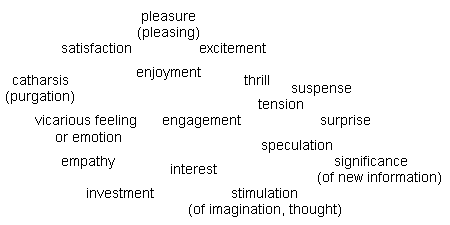
A mapping of potential audience responses to a "good" narrative.
At the center, we have engagement. This seems to be the key response to a good narrative--we are "sucked in". The reasons for this are scattered around the edges of the map. To the left, we see the emotional responses: empathizing with the characters, feeling vicarious emotions, and possible "purging" those emotions. In the lower-right corner we see the "rational" responses--speculation on the future of the plot and waiting for more information on what will happen next. This feeds into the top-right corner--the tension of a particularly gripping tale. And at the top, we see the results of a good narrative completed--satisfaction and enjoyment.
Though there are some natural groupings, this map is still a tangled weave. Empathizing with characters can increase tension if harm might come to those characters. If you are a particularly cerebral person, stimulation of thought and imagination might make for the greatest satisfaction.
Somewhere in this tangle is the meaning of the "complication" axis of our plot diagram. As the plot continues, our "tension" or "interest" rises and falls. Laurel holds that this is related to generated and satisfied information needs. Questions concerning the current state of affairs and potential futures actions are constantly being raised and answered. We are interested in learning significant facts.
But what makes these facts significant? Why do we care? Perhaps because we empathize with hero, and want to know what will happen to him. We are in a state of doubt about his future because there is tension or conflict in the story--will he overcome the challenges he faces, and if so, how?
Clearly, there exists this tangled semantic web of terms because they all related to each other. (And none of the authors reviewed have offered viable models to explain the relationships present here.) But if we can call all this tension/interest/wondering our "engagement" to the story, there still seems to be two phases of user response. First of all, we want to be "engaged" during the story. But, when the end comes, we also want to be "satisfied" after the story. It is possible to be engaged for the length of a narrative, but yet, when we find the end is weak and improbable, we can still be unsatisfied with the performance overall.
This confusion between how, exactly, plot structure causes user response demonstrates the tension between objective rules of a science and the subjective results of an art. Though we may determine the "craftsman's traditions" of how to compose a story, it does not mean we will achieve an engaging and satisfying result. We may find that we can break the rules--start the story with the climax, include two plotlines--and still produce a great story. And we can follow the rules and produce a dull narrative.
Yet we know this much: for whatever reason, a well-crafted narrative will keep us engaged and leave us satisfied.
A topic covered by none of these authors is the role of meta-narrative on audience response. From Aristotle, we see that, even two and half millennia ago, there were different kinds of narrative--tragedy, epic, comedy. And these different kinds, even when sharing the same medium and similar manners, had different rules concerning their construction and different audience expectations. For instance, characters should have noble purpose in tragedy but could be acceptably ignoble in comedy. Tragedy should restrict itself to a single action, but it is acceptable for epics to comprise of multiple (through related) episodic actions.
As Freytag stated, rules of structure provide a framework for both creation and criticism. Meta-narrative cues give the audience a clue as to what sort of narrative they are about to experience. Some of these depend on the medium: as Laurel pointed out, narratives differ whether they are meant to be performed or read. And even in the same medium, narratives can have different manners: audience expectations are very different for improvisational theatre than they are for scripted comedy.
Among all the narratives of a particular medium and manner, we often differentiate in terms of genre. Genres can provide very specific constraints on a narrative. Some examples are:
Sometimes even an author is established enough to have associated "genre" information:
Genres set up audience expectations. This can help the audience approach the narrative properly. For example, they know not to get too attached to the characters in a horror film. It can also sometimes be used to surprise the audience by breaking the rules--such as killing the characters off in the "wrong" order in a horror film.
A narrative may have a theme or issue it wishes the audience to consider. This is very closely related to point-of-view and Meadows's notion that perspective is essential to all narratives. We may enjoy narratives for technical reasons--it has our favorite actress or great cinematography. In ancient Greek tragedies, roles in the drama were assigned to different actors based on the thematic connection between the roles and prestige of the actor. These are all further example of meta-narrative shaping our experience of a narrative.
We have now explored narrative at some length. But we began this review in the hopes of learning how to produce satisfying interactive narratives.
By interactive narrative, I mean a narrative in which the audience can affect a significant change on the narrative.
Audiences can already affect traditional narratives in small ways. Their responses affect actors performing a drama on stage. They can choose how fast they read a book or when they put it down. They choose which movies they go to see at the cinema. But we usually intend a higher degree of interactivity than this when discussing interactive narrative.
The most common assumption behind interactive narrative is that the audience will be able to direct the plot as it unfolds, and so this will be our main interest. However, it should be remembered that narratives can be made interactive to a smaller degree. This can be as minor as the audience selecting the initial parameters, such as the setting or genre of the story. They may justify character actions, or choose different points-of-view from which to view the action.
Meadows explores the spectrum of current plot structures common in today's computer game interactive narratives. They range from the "impositional", in which the user uncovers a single plotline, to "expressive" structures, in which users are free to generate their own plots in an open, simulated environment.

A nodal plot structure gives an author the most narrative control. It can have a proper, pre-constructed plot structure. The difference from traditional narrative is that there are decision points where the user needs to complete some task in order to advance the story. Frequently, these are "do-or-die" decision points. If the user fails, his character dies, and he reloads a saved game and tries the task again.
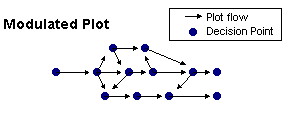
A modulated plot structure has multiple plotlines. Decisions the user makes at certain points will result in a different sequence of events. However, though there may be multiple possible endings, all the possible storylines are known by the game author. By playing multiple times, the user can eventually experience all the different plot lines.
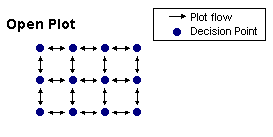
An open plot structure has no discernable story arc. It provides a world for users to explore, and they must provide their own justification for their actions and create their own narrative in this way.
These three interactive plot diagrams demonstrate the difficulty present in today's approaches to interactive narrative). A nodal plot structure has a strong narrative, but the interaction does not change the story--it's all narrative. An open structure leaves the narrative creation entirely up the user--it's all interaction. The modulated structure is little better. Because all the plots already exist, it is like a collection of overlapping nodal structures glued together at the starting point. There are still a limited number of pre-existing possible narratives.
This is not to say that these three structures cannot provide very engaging and extremely satisfying experiences. But it seems that there must be other approaches.
Laurel insightfully reveals the problem with existing approaches to interactive narratives (and many HCI systems in general). We tend to start with a narrative, and then add the interaction. It is like performing a play with the audience milling around among the actors. The subtle, but key, difference Laurel calls for is to make the audience actors too. Instead of worrying about how having the audience on stage is going to mess up the planned script, start with the audience on the stage as actors and then generate the script together!
But there is still a problem of balance here. Treating the audience like actors does not make them behave like actors. As Johnstone explains, new improv students often have difficulty keeping up an extended improv because they tend to "block" offers. That is, when offered a potential plotline opportunity, they will decline it and keep with the current routine. As mentioned before, this can cancel the current routine--it doesn't go anywhere. (Part of the reason for this blocking is related to attempts by novices to maintain control and higher status than the other actors.) A collaboration between a user and a system to generate a narrative cannot leave too much up to the user. This is precisely why existing open plot structure games can be unsatisfying--they leave all the narrative work to the player.
Even if we are continually creating new plots for the user, we must be cautious not to err in the opposite direction of leaving the player too few choices. Users frequently refuse to go along with a plot. This may be because they are obstinate, bored, or simply curious about the abilities of the system to adapt to their actions. The system may be poorly designed, so they may not know what they need to do, or how to accomplish it even if they do know. Or the system may simply not support the choices they want to make. Laurel explores how we can use constraints, both intrinsic and extrinsic to the narrative context, to attempt to guide users into choosing allowable actions.
If we have been generating narratives and then trying to add interaction, starting with interaction and then trying to generate a narrative will be a new approach. It could reduce the current tension between authors and players over control of a pre-written plot. But a new approach does not mean a cure-all. The same problems of balance--making the plot flexible enough but still substantial--remains to be dealt with. And it raises new issues of how best to generate narratives. This is hard enough for a computer to do alone, but it must also collaborate with the user. Improv and one-step-at-a-time plot creation technique may well be the key. However, unlike humans, with a long history of "instinctual" storytelling and meta-narrative knowledge, computers may well need to mind the structure and the content.
"Poetry in general seems to have sprung from two causes, each of them lying deep in our nature. First, the instinct of imitation... Next, there is the instinct for 'harmony' and rhythm" (Aristotle, Poetics IV).
Story-telling--the "imitation of action"--is indeed a deep-seated human activity. Like all "instinctual" activities, it becomes very hard to tease apart the different components and rules that comprise the activity. Yet, based on this review of five authors, we have learned a few things that might help us add interaction to our narratives.
First, action is the first principle of narrative. In order to produce this action, characters are needed. And in order to understand those characters, we must be aware of the thoughts that motivate their actions.
The produced action should be complete and connected. The included events should seem probable, or even necessary, based on the motives and abilities of the characters. All included events should be necessary to furthering the action. In this way, the action becomes a unified plot. There may be multiple plotlines, but this is generally not encouraged.
There is a general structure to a plot. The setting and main characters should be introduced early, then the focus should be on bringing the rising action to a climax, and finally all the loose threads (unfinished "routines") should be tied off in the falling action. In this way, a plot has a clear beginning, middle, and end.
The structure of the plot is directly related to the audience's response. During the narrative, the audience should be "engaged". Events in the plot can increase and decrease this engagement. Engagement is related to a number of factors, including empathy with the characters, enjoyment of the emotions generate, suspense, and a simple desire to know what happens next. At least part of this tension likely stems from the conflict or tension faced by the characters within the plot itself. If the audience is engaged throughout the narrative, and the plot is unified and complete, they will likely be satisfied at the conclusion.
The enjoyment of narrative is influenced by a number of meta-narrative factors, most notable of which are the medium, manner, and genre. The genre, in particular, inform the audience what to expect and how to judge the narrative.
And we must remember why we tell narratives in the first place--to convey a perspective.
We have succeeded in synthesizing a basic outline of narrative theory. We can use this as a foundation for future critiques of generated narratives. As a potential avenue for generating satisfying interactive narratives, more research should be done into automatically and collaboratively generating stories. Improv is likely a fruitful source of techniques apropos to this sort of creation--creating routines, breaking them, reincorporating them, completing the created patterns to form a plot. Computers may be at a disadvantage, lacking the (repressed) human capacity for spontaneous creation. But this may be outweighed by limiting creation to a tight domain, using meta-narrative constraints, and relying on some collaboration from the user. Other potential sources of techniques are table-top role-playing games and the study of tropes, or story elements.
This review is only the first step.
Aristotle. Poetics. Translated: S. H. Butcher. Introduction: Francis Fergusson. New York: Hill and Wang, 1961.
Freytag, Gustav. Technique of the Drama. Translated: Elias J. MacEwan, from 6th German edition. Chicago: S.C. Griggs & Company, 1895.
Johnstone, Keith. Impro: Improvisation and the Theatre. NY: A Theatre Arts Book/Routledge, 1979.
Laurel, Brenda. Computers as Theatre. Reading, Mass: Addison-Wesley Publishing Co., 1991.
Meadows, Mark Stephens. Pause & Effect: The Art of Interactive Narrative.
Indianapolis, IN: New Riders, 2003.
| ~ztomasze Index:
CIS: 699 http://www2.hawaii.edu/~ztomasze |
Last Edited: 13 May 2005 ©2005 by Z. Tomaszewski. |